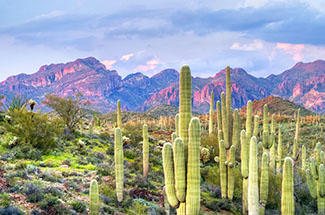How Plants Survive in the Desert
How Plants Survive in the Desert
By: John Eisenhower, Certified Arborist | Rosie on the House Certifed Partner Integrity SavATree
One third of the earth's land surface is desert but, surprisingly, deserts around the world support an incredible array of shrubs, flowers, cacti and trees. Some plants, called xerophytes, have adapted their physical structures to suit the rigors of the desert environment. Xero- means dry and -phyte means plant.
Some desert plant adaptations:
 Low, Compact Growth Habit
Low, Compact Growth Habit
This reduces a plant's exposure to sun and wind and water loss through evaporation.
Smaller Leaves. Seasonal Leaves or No Leaves
Small leaf surface area reduces evaporation. Some leafless plants photosynthesize through their bark or stems.
Leaves That Drop During Hot Weather
Summer deciduous plants like ocotillo, acacia and mesquite shut down when they can't afford to lose more water through photosynthesis. They cope by becoming semi-dormant during droughts, then re-foliate as soon as water is available or cooler weather arrives in the fall.
Hair on Leaves
Small hairs help shade leaves and reduce transpiration by reflecting sunlight and inhibiting air movement which tends to dry the leaf surface.
Non-Porous Covering on Leaves Such as Wax
Agaves and some cacti have a thick cuticle that reduces water loss by transpiration. The smooth, green bark of Palo Verdes also seals in moisture as well as produces energy through photosynthesis.
Unique Leaf Shapes and Responses
Agaves have funnel-shaped leaves. Saguaros and others have pleats. Other plants have spines to protect against thirsty, hungry animals.
Control of Water Loss
Some plants have fewer stomata on leaves or night-time opening of stomata.
Extensive, Durable Root Systems
Mesquites can have very deep roots. Cacti can have expansive root systems made up of a large number of small fibrous roots extending out a great distance from the plants.

Large Water Storage Systems
Some plants like saguaros and barrel cacti have a large water storage capacity to help them survive times of drought.
Slow Growth
Desert plants often grow slowly, metabolizing at a pace requiring less energy and less water.
Short Life Cycle
Some plants, called ephemerals, germinate in response to rain, then grow, flower and die within one season. In this way, these species can survive several years of drought. Their seeds may lie dormant for several years until seasonal rainfall is sufficient for them to germinate again.
Allelopathy
Some plants produce chemicals that inhibit the germination or growth of other nearby plants. This protects them from competition for water and nutrients.
As you can see, we humans are not alone in our efforts to survive the extreme conditions of desert living! While marveling at the adaptations made by these amazing plants, give yourself some credit too for surviving another summer in the Sonoran Desert.
Lessons to learn from our botanical desert companions:
- Lay low. Avoid sun exposure.
- Slow your pace and perspiration.
- Avoid strenuous activity in the hottest part of the day. Drink plenty of water and carry extra with you.
- Plant a tree this year to nurse you through the next ten or twenty!
###
